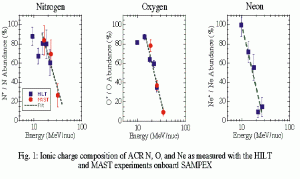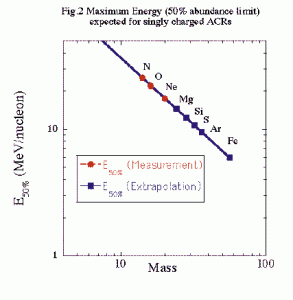ACR Ionic Charge States
SAMPEX’s high inclination, low altitude polar orbit was designed to determine the ionic charge composition of Anomalous Cosmic Rays (ACR). It was found that ACRs (N, O, and Ne) below ~ 350 MeV are predominantly singly ionized, thus confirming the hypothesis of interstellar neutrals being the source of ACRs. At higher energies, however, multiply charged ions (Q >= 2) dominate, i.e. the ionic charge composition varies with energy. This is demonstrated in Fig.1
showing the abundance of singly ionized ions for N, O, and Ne as a function of energy/nucleon. It is found that the total energy, E50%, above which multiply charged ions dominate, is about the same (~350 MeV) for N, O, and Ne, independent of the mass of the element. Because multiply charged ACR ions are generated by charge exchange processes in the outer heliosphere, this finding has interesting implications for the acceleration process and the search for other minor ions of possibly ACR origin that were recently discovered with experiments onboard WIND and the Voyager spacecraft:
(1) The fact that singly charged ions dominate at energies below ~ 350 MeV shows that the acceleration to these energies is faster than the charge exchange losses and can be estimated to be of the order of ~ 3 years. The only process that seems to be compatible with this time scale is acceleration at the termination shock of the heliosphere at low latitudes.
(2) This acceleration process also predicts a typical maximum energy for all ions that does not depend on mass but on the ionic charge, i.e. all singly charged ions injected at the termination shock would be accelerated to the same total energy, consistent with the observations.
(3) The measurement can also be used to estimate the energy range, where other singly charged ions, injected into the same acceleration process, could be expected. Figure 2
shows the 50% energy limit for other ions, extrapolating the results from N, O, and Ne to other elements. Figure 2 shows that singly ionized ions with larger mass (e.g. Mg, Si, S, Ar, Fe) would be expected at considerably lower velocities (lower energy/nucleon) than N, O, and Ne. This could possibly explain why ACR Ar + was not observed in the SAMPEX energy range (E >10 MeV/nuc). It would also be consistent with the recently discovered low energy flux increases of other minor ions with much larger mass than O (e.g. Mg, Si, S), if these ions would be singly charged.
Contributed by Berndt Klecker (Max-Planck-Institut fuer Extr. Physik) and Dick Mewaldt (Caltech)
«Return to the Results page

